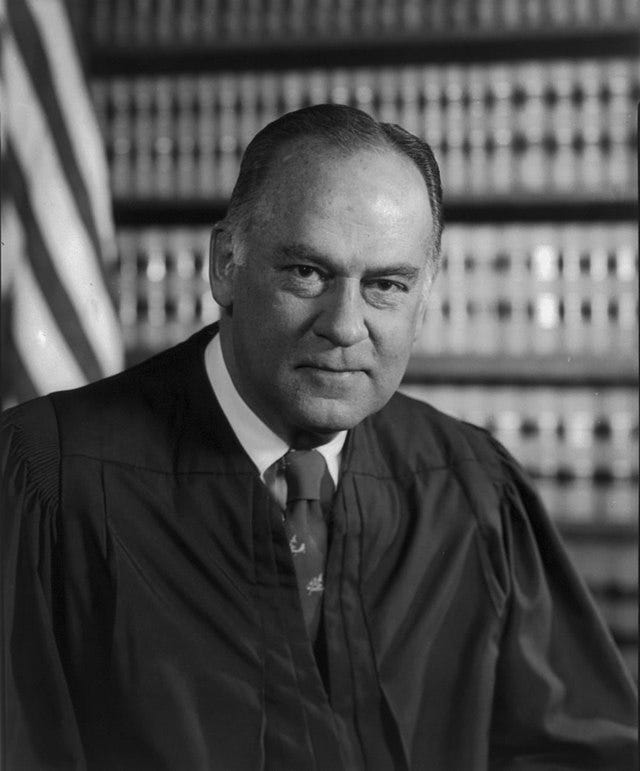Judicial-Confirmation Trivia Answers
How'd you do?
So here are the answers (well, I think they’re the right answers) to last week’s trivia questions:
1. Who was the first lower-court federal nominee to have a vote on a cloture motion on his or her nomination?
Stephen Breyer on his First Circuit nomination in 1980.
As I’ve recounted more fully, Breyer had an extraordinarily expedited confirmation process. Jimmy Carter nominated him to the First Circuit on November 13, 1980—nine days after Reagan defeated Carter’s bid for re-election and the Republicans won control of the incoming Senate. Senate majority leader Robert Byrd aimed to get Breyer confirmed by the full Senate on December 9, but he was unable to get unanimous consent to proceed to a floor vote, so a cloture motion was filed. The motion obtained 68* yes votes, eight more than it needed. Sixteen Republican senators voted for cloture. Three Democratic senators voted against, and three others didn’t vote—which was the practical equivalent of a vote against. Breyer’s nomination was then confirmed by a vote of 80-10.
2. Before 2017, who was the most recent Supreme Court nominee to face a vote on a cloture motion on his or her nomination as part of an effort to filibuster the nomination?
Samuel Alito in January 2006.
On vacation in Davos, Switzerland, Democratic senator John Kerry urged a filibuster of Alito’s nomination to replace Justice Sandra Day O’Connor. The filibuster effort failed, as the cloture motion received 72 yes votes. Among the 25 Democratic senators who supported the filibuster were Joe Biden, Barack Obama, Chuck Schumer, Harry Reid, Dick Durbin, and Hillary Clinton.
Before Alito, the only Supreme Court nominees to face cloture votes were Abe Fortas on his nomination to be chief justice in 1968 and William H. Rehnquist on two separate occasions: on his nomination to be associate justice in 1971 and on his nomination to be chief justice in 1986.
3. Before 2017, who was the most recent Supreme Court nominee to have a cloture motion on his or her nomination fail?
William H. Rehnquist, as associate justice, December 10, 1971.
The cloture motion on Rehnquist’s nomination received 52 affirmative votes and 42 negative votes. In order to pass under the rule then in effect, it needed to obtain two-thirds of senators voting—63 yes votes. Despite the defeat of the cloture motion, opponents of Rehnquist’s nomination agreed to a final confirmation vote that same day. Rehnquist was confirmed by a vote of 68 to 26.
The cloture motion on Abe Fortas’s nomination in 1968 was also rejected, as it received only 45 yeas versus 43 nays. His nomination was then withdrawn.
The cloture motion on Rehnquist’s nomination to be chief justice in 1986 passed by a vote of 68 to 31.
4. Who was the most recent Supreme Court justice to take his or her seat by recess appointment?
Potter Stewart, on October 14, 1958, filling a seat vacated by Harold Burton.
President Eisenhower nominated Stewart to a lifetime position in the same seat in January 1959. The Senate confirmed that nomination in May 1959, and Eisenhower then appointed Stewart to that seat.
Eisenhower had done the same two-fer—a recess appointment followed by a lifetime Senate-confirmed appointment—for Chief Justice Earl Warren (October 1953 and March 1954) and Justice William J. Brennan Jr. (October 1956 and March 1957).
5. Who was the most recent lower-court judge to take his or her seat by recess appointment?
William H. Pryor Jr., to the Eleventh Circuit, on February 20, 2004.
President George W. Bush nominated Pryor to the Eleventh Circuit in April 2003, but Senate Democrats filibustered his nomination, as they mustered 43 votes to defeat a cloture motion. In June 2005, after the so-called Gang of 14 Agreement ensured an up-or-down vote on Pryor’s nomination, the Senate confirmed Pryor’s nomination by a vote of 53 to 45. Pryor is now chief judge of the Eleventh Circuit.
In December 2000, Bill Clinton recess-appointed Roger L. Gregory to the Fourth Circuit. Bush appointed Gregory to a lifetime seat in 2001.
In January 2004, Bush recess-appointed Charles W. Pickering to the Fifth Circuit. Pickering retired from judicial service in December 2004.
(I expect to address the Pryor, Gregory, and Pickering nominations more fully in later posts.)
* * *
Congrats to a reader who goes by the name of ringwiss—a self-described “parliamentary maven”—who managed to provide correct answers to all five questions. (I would have gotten only #2 and #5 right.)
* In the original version of this post, I mistakenly stated that the motion obtained 71 yes votes.



